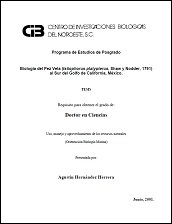Contenidos estomacales, isótopos estables y elementos traza en peces de Santa Rosalía, Golfo de California
Abstract
"En el poblado de Santa Rosalía, Baja California Sur, ubicado en la costa occidental de la parte central del Golfo de California, se han reportado altas concentraciones de elementos traza en los sedimentos costeros. Estas altas concentraciones están asociadas directamente con el aporte natural derivado de la composición geológica de la zona. Sin embargo, existen áreas fuertemente influenciadas por la actividad minera que se ha estado realizando en la zona. Estas actividades han resultado en un enriquecimiento de elementos traza en los sedimentos marinos. Estudios sobre concentración de elementos traza en tramas tróficas marinas indican que las especies acuáticas pueden bioacumular estos elementos en concentraciones proporcionalmente mayores a las del ambiente en el que se desarrollan y, en ocasiones, pueden ser participe en procesos de biomagnificación. En el presente trabajo se analizó la concentración de elementos traza, Cadmio (Cd), Plomo (Pb), Cobre (Cu), Zinc (Zn) y Fierro (Fe), en peces de distinto nivel trófico que habitan arrecifes rocosos. Las fuentes de alimento de los peces fueron analizadas a partir del contenido estomacal y de isótopos estables δ13C y δ13N. Los peces pueden ser indicadores del flujo de éstos elementos traza, ya que transfieren energía entre comunidades pelágicas y bentónicas de acuerdo a su nivel trófico. Las especies de estudio fueron Kyphosus azureus, Stegastes rectifraenum y Balistes polylepis, de hábitos herbívoro, omnívoro y carnívoro, respectivamente. Las capturas de peces se realizaron en tres sitios aledaños a la costa de Santa Rosalía, uno cercano a la mina (Las Cuevitas), y los otros dos sitios sin influencia minera (Punta Gorda y Frailes); en todos los sitios el muestreo se realizó mediante buceo libre utilizando arpones de tipo hawaiano en los meses de mayo y septiembre del 2015. Los peces capturados fueron disectados para recuperar el contenido estomacal y obtener muestras de músculo para el análisis de la concentración de isótopos estables δ13C y δ13N y elementos traza. La especie K. azureus mostró una dieta herbívora en todos los sitios y estaciones, principalmente constituida por macroalgas rojas; se observó que S. rectifraenum se alimenta de macroalgas rojas, detritus y pequeños invertebrados, mientras que B. polylepis presentó una dieta constituida por moluscos, en su mayoría..." "In Santa Rosalía, Baja California Sur, on the western coast of the central Gulf of California, high concentrations of trace elements have been reported in coastal sediments. These high concentrations are directly associated with the natural contribution derived from the geological composition of the zone. However, there are areas strongly influenced by the mining activity that has been taking place in the area. These activities have resulted in an enrichment of trace elements in marine sediments. Studies on the concentration of trace elements in marine trophic plots indicate that aquatic species can bioaccumulate these elements in concentrations proportionally greater than those in the environment in which they are developed and may sometimes be involved in biomagnification processes. In the present work the concentration of trace elements, Cadmium (Cd), Lead (Pb), Copper (Cu), Zinc (Zn) and Fierro (Fe) are analyzed in fish of different trophic level that inhabit rocky reefs. Fish food sources were analyzed from the stomach contents and stable δ13C and δ13N isotopes. Fish can be indicators of the flow of these trace elements, since they transfer energy between pelagic and benthic communities according to their trophic level. The species of study were Kyphosus azureus, Stegastes rectifraenum and Balistes polylepis, of herbivorous, omnivorous and carnivorous habits, respectively. The catches of fish were carried out in three sites near the coast of Santa Rosalía, one near the mine (Las Cuevitas), and the other two sites without mining influence (Punta Gorda and Frailes), and at all sites by free diving Using Hawaiian type harpoons in May and September of 2015. The captured fish were dissected to recover the stomach contents and to obtain muscle samples for the analysis of the stable isotope concentration δ13C and δ13N and trace elements. The species K. azureus showed a herbivorous diet in all the sites and stations constituted by red macroalgae, mainly; S. rectifraenum feeds on red macroalgae, detritus and small invertebrates, while B. polylepis presented a diet consisting of mollusks, mostly..."
Collections
Related items
Showing items related by title, author, creator and subject.
-
PROMOCIÓN DEL PERIFITON PARA EL CULTIVO DE CAMARÓN BLANCO: HACIA UNA ACUICULTURA ECOLÓGICA
DOMENICO VOLTOLINA LOBINA; JUAN MANUEL AUDELO NARANJO; MARIA DEL ROSARIO PACHECO MARGES -
Suelo y Erosión
YOLANDA LOURDES MAYA DELGADO


